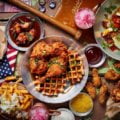There’s a particular phase of my circle of relatives’ fridge reserved for the large, apparently bottomless tub of chickpea flour — or as many other Indians who additionally rely upon it and we call it, besan — that my parents maintain on hand. We’re now not gluten-free, nor will we do several baking. Yet chickpea flour shows up anywhere in our meals. It’s the nutty coating for my mother’s inexperienced beans spiced with earthy ajwain, the important thing element in her creamy, tangy, yogurt-based totally soup, kadhi, and the bottom for our favorite form of laddoos, candy, fudge-like balls flavored with ghee, sugar, and nuts.
Across the numerous local cuisines in India, chickpea flour is a not unusual denominator: Gujaratis flip it into pudla, skinny, savory crepes laced with turmeric and chilies. In Karnataka and Maharashtra, it can be observed in junk, such as spicy porridge. And in Andhra Pradesh, it’s far thicker. In Senagapindi Kura, it is an onion-heavy stew. For the USA’s huge vegetarian population, eggs are often considered non-vegetarian; chickpea flour blended with water is a powerful omelet replacement.
Indians—alongside the Nepalese, Pakistanis, Italians, the French, and plenty of others—have been cooking with chickpea flour for hundreds of years. Americans, then again, only seem to have woken up as much as the ingredient in the last decade or so. And they have woken up massively.
It’s difficult to trace the exact foundation of chickpea flour’s surprising recognition in the U.S. Anna Stockwell, the senior meals editor of Epicurious and Bon Appétit, stated she first started seeing chickpea flour around 2009 on gluten-free blogs. Stockwell is gluten-free herself and became excited to find a recipe for savory chickpea pancakes.
She didn’t realize chickpea flour’s culinary background very well, but she became excited without delay. “Its binding strength became magic,” she recollects. All you need to do is combine chickpea flour and water, and suddenly, you may make flatbread, cakes, or vegetable pancakes.” Still, Stockwell noticed it as a niche aspect—something only gluten-loose clients cared about. She wasn’t even allowed to call for it in Epicurious recipes.
Slowly, however, without a doubt, that began to exchange. In 2010, one of the extra popular recipes from Plenty, Yotam Ottolenghi’s bestselling cookbook, became a chickpea flour pancake, or socca, because it’s recognized in France, layered with tomatoes and onions. In 2015, food and health author Camilla Saulsbury wrote the famous e-book The Chickpea Flour Cookbook. That is followed a year later by Chickpea Flour Does It All through blogger Lindsey Love.
Lani Halliday, the founder of Brutus Bakeshop, a gluten-free Brooklyn bakery, says she noticed a big uptick in chickpea flour-based, gluten-loose sweets to be had about a decade in the past. Chickpea flour is nicely labored for baked goods “as it can keep air bubbles and moisture,” she says. Plus, “it becomes cheap, it was accessible, and it becomes versatile.” Halliday released her bakery in 2015. One of her bestselling items amongst gluten-loose and non-gluten-loose customers turned into a chocolate cupcake made with chickpea flour.
Stockwell believes the mainstreaming of chickpea flour is related to at least one agency — Bonanza. The agency started out generating its chickpea flour-based pasta in 2014, and via 2017, it was in eight 000-plus grocery stores and had raised $eight million in funding. The key to the company’s success? It failed to market itself as a gluten-unfastened product exclusively. Instead, it changed into branded as health food. It was one of the first opportunities for pasta with a smooth, al dente texture, similar to the actual element.
“I had buddies who had never heard of chickpea flour; however, now they devour Bonanza,” Stockwell says. “It’s no longer because they’re seeking to eat gluten-loose but because it’s a delicious and higher-protein pasta. It’s a choice to empty carbs.” This year, Epicurious finally became allowed to submit recipes with chickpea flour. Dennis Vaughn, the CEO of Bob’s Red Mill, says chickpea flour has become a clear bestseller of a few of the agency’s sundry flour alternatives within the past five years.
“My grocery save would not even bring beef,” Stockwell says, “however they convey Bob’s Red Mill” chickpea flour. It has been weird to watch this factor in many approaches that have usually felt so quotidian to me grow to be so ubiquitous so quickly within the U.S. This is certainly now not the primary Indian element or dish this has taken place in. Consider turmeric, chai, or khichdi, which have all been claimed by the well-being community and meals bloggers as their personal, regular instances without giving due credit to Indian delicacies. It baffles me that most of the human beings I speak to are stunned to hear that chickpea flour has long been a common aspect of my family’s cooking.
On the other hand, it became important to me after I began writing my new cookbook, Indian-ish. People may want to discover the elements for the dishes of their average grocery store. Because chickpea flour is now so commonplace, I could include recipes like the addictive chickpea flour, inexperienced beans, and the silky, soupy kadhi.
I’m no longer against chickpea flour coming into the mainstream. But I desire that more of the tales I examine about it, or the recipes I saw that featured it, did not body it as a logo-new discovery and completely ignore its heritage. No one subculture can “personal” an ingredient — I’m penning this with a container of Bonanza chickpea pasta in my kitchen cabinet — but let’s not deal with food as it exists in a vacuum. There’s a context for that chickpea flour flatbread you’re making for dinner. Could you not take it with no consideration?












